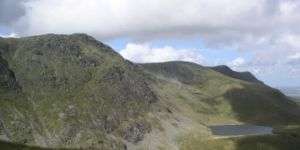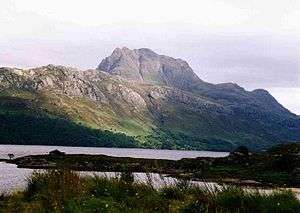Aran Fawddwy
Aran Fawddwy is a mountain in southern Snowdonia, Wales, United Kingdom. It is the highest point (county top) of the historic county of Merionethshire (for local government purposes, it lies within the current council area of Gwynedd). It is the only peak in Wales outside North Snowdonia above 900m, and higher than anywhere in Great Britain outside Northern Snowdonia, the Scottish Highlands (and islands) and the Lake District. The nearest urban centres to the mountain are Dinas Mawddwy to the south, Llanymawddwy to the southeast, Llanuwchllyn on the shores of Bala Lake to the north, and Rhydymain to the west. The nearest settlements with around 2,000 people are Bala and Dolgellau. On the eastern slopes of Aran Fawddwy is the small lake named Creiglyn Dyfi, the source of the River Dyfi. Its sister peak is Aran Benllyn at 885 metres (2,904 ft).[2] There is also a middle peak- Erw y Ddafad-ddu.
| Aran Fawddwy | |
|---|---|
 Aran Fawddwy (on left) and Creiglyn Dyfi | |
| Highest point | |
| Elevation | 905 m (2,969 ft) [1] |
| Prominence | 670 m (2,200 ft) |
| Parent peak | Snowdon |
| Listing | Marilyn, Hewitt, Nuttall |
| Naming | |
| English translation | Mawddwy peak |
| Language of name | Welsh |
| Pronunciation | Welsh: [ˈaran ˈvauðwɨ] English approximation: ARR-ən-VOWDH-wee |
| Geography | |
| Location | Gwynedd, UK |
| Parent range | Snowdonia |
| OS grid | SH862223 |
| Topo map | OS Landranger 124, 125 |
| Listed summits of Aran Fawddwy | ||||
| Name | Grid ref | Height | Status | |
|---|---|---|---|---|
| Aran Benllyn | SH866243 | 885 m (2,904 ft) | H, N | |
| Erw y Ddafad-ddu | SH864234 | 872 m (2,861 ft) | H, N | |
| Foel Hafod-fynydd | SH876227 | 689 m (2,260 ft) | H, N | |
| Gwaun y Llwyni | SH857204 | 685 m (2,247 ft) | H, N | |
| Gwaun Lydan | SH880211 | 632 m (2,073 ft) | N | |
| Waun Camddwr | SH862223 | 621 m (2,037 ft) | N | |
| Pen yr Allt Uchaf | SH867192 | 620 m (2,030 ft) | H, N | |
A cairn is placed on the eastern ridge as a memorial to RAF Mountain Rescue team member Michael Robert Aspain who was struck and killed by lightning in 1960.[3]
Ascent
Aran Fawddwy is best ascended from Cywarch in the south,[4] although a longer ridge climb is possible from the Bala side. The mountain forms a long rocky ridge with Aran Fawddwy as the highest point, but Aran Benllyn as another notable summit. The western side is extremely steep, falling spectacularly in crags to a series of glacial cwms or corries which also enclose two small lakes (Creiglyn Dyfi and Llyn Lliwbran). The eastern slopes are also rocky, but less steep and more uniform. The view from the summit is extensive covering most of the mountain ranges of North Wales and as far south as the Brecon Beacons and Pembrokeshire peninsula. On an exceptionally clear day, the Lake District in England and Wicklow Mountains in Ireland are visible.[5]
Geography
Aran Fawddwy, which is only 9.5 metres (31 ft) short of being a member of the Welsh 3000s, is the highest peak in the Aran mountain range and the 16th highest summit in Wales. The other two Marilyns in this range are Glasgwm and Esgeiriau Gwynion.[6]
It is the highest British mountain south of Snowdon and is the principal summit of the predominant southwest-northeast ridge between Dolgellau and Bala, southern Snowdonia, a ridge that continues westwards as Cadair Idris.
References
- Crocker, Chris; Graham Jackson. "Mountaineering & Rock Climbing in the UK: Aran Fawddwy". Database of British Hills. Mountain Days.net. Archived from the original on 19 July 2011. Retrieved 8 April 2008.
- Crocker, Chris; Graham Jackson. "Mountaineering & Rock Climbing in the UK: Aran Benllyn". Database of British Hills. Mountain Days.net. Archived from the original on 19 July 2011. Retrieved 8 April 2008.
- Image from www.geograph.org.uk
- Walk 1190 - Aran Fawddwy from Cwm Cywarch - Snowdonia Gwynedd - a walk description from Walking Britain
- http://viewfinderpanoramas.org/panoramas/WAL/FAWDDWY.gif, View from Aran Fawddwy summit
- Nuttall, John & Anne (1999). The Mountains of England & Wales - Volume 1: Wales (2nd edition ed.). Milnthorpe, Cumbria: Cicerone. ISBN 1-85284-304-7.
External links

- Computer-generated summit panoramas Aran Fawddwy Index
- www.geograph.co.uk : photos of Aran Fawddwy and surrounding area


